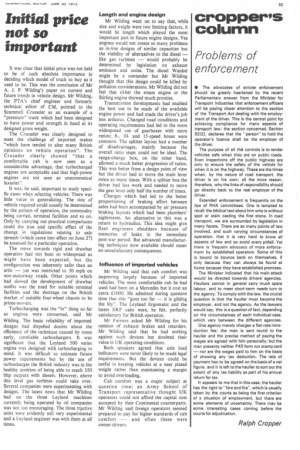cropper's column
Page 35

If you've noticed an error in this article please click here to report it so we can fix it.
Problems of enforcement
• The advocates of stricter enforcement should be greatly heartened by the recent Parliamentary answer from the Minister for Transport Industries that enforcement officers will be paying closer attention to the section of the Transport Act dealing with the employment of the driver. This is the central point for achieving compliance for many aspects of transport law; the section concerned, Section 9212). declares that the -person" to hold the operator's licence shall be the employer of the driver.
The purpose of all thd controls is to render vehicles safe when they are on public roads. Even inspections off the public highway are only to ensure the safety of the vehicle for when it is on the highway. These are the times when, by the nature of road transport, the driver is on his own: all the more reason. therefore, why the links of responsibility should go directly back to the real employer of the driver.
Extended enforcement is frequently on the lips of RHA committees. One is tempted to recall the biblical text about him who is without spot or stain casting the first stone. In road transport, we are surrounded by legislation in many facets. There are so many points of law involved, and such varying circumstances of operation, that it is very hard to know all aspects of law and so avoid every pitfall. Yet there is frequent advocacy of more enforcement by established operators. Some of this is bound to bounce back on themselves, if only because they can always be found at home because they have established premises.
The Minister indicated that his main attack would be directed towards drivers' agencies. Hauliers cannot in general carry much spare labour, and to meet short-term needs turn to the agency. To comply with the law, the crucial question is that the haulier must become the employer, and not the agency. As the lawyers would say, this is a question of fact, depending on the circumstances of each individual case, which vary between the different agencies.
One agency merely charges a flat-rate introduction fee; the man is sent round to the haulier and the precise method of paying the wages are agreed with him personally; but the man presents neither P45 form nor stamp card — nor are the wages paid to him on the basis of showing any tax deduction. The rate of payment has to be agreed on the basis of a net figure, and it is left to the haulier to sort out the extent of any tax liability as part of his annual return for tax.
It appears to me that in this case, the haulier has the right to "hire and fire", which is usually taken by the courts as being the first criterion of a situation of employment, but there are some elements of uncertainty. There may be some interesting cases coming before the courts for adjudication.




























































































